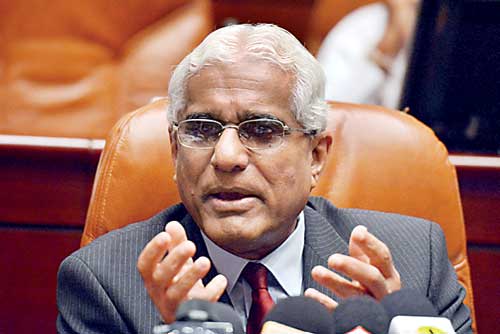Friday Nov 15, 2024
Friday Nov 15, 2024
Thursday, 9 February 2017 00:10 - - {{hitsCtrl.values.hits}}
By Uditha Jayasinghe
Sri Lanka has “manageable” non-roll over debt commitments of $ 2.6 billion for 2017, the Central Bank said yesterday, outlining plans to manage external payments and aim for $ 7.5 billion in reserves by December mostly on planned asset sales by the Government. 
Central Bank Governor Dr. Indrajit Coomaraswamy told reporters the Government planned to raise a syndicated loan up to $ 1 billion and a sovereign bond with a cap of $ 1.5 billion over the next few months to facilitate debt commitments and other activities. A proposal on the sovereign bond is expected to be presented to Cabinet within the next fortnight, he added.
“It is in our view manageable. The challenge for the country is to increase non-debt creating foreign inflows. We feel we need to do much better in terms of exports and FDI. If that happens, the reliance on external borrowings would be reduced.
That is really the key message from the Central Bank’s point of view that we would like to give. Our short-term borrowings are relatively high. We would like them to be a lower proportion in relation to our reserves. It is a manageable situation but it is a situation that needs to improve,” he said.
The Governor also backed planned asset sales by the Government, describing them as “tremendously beneficial” to assist in liability management. The projected earnings from the sale of non-strategic State assets including Hyatt, Hilton, Water’s Edge and Grand Oriental Hotel along with Lanka Hospitals and Mattala Airport could be as high as $ 1 billion, the Governor said. The Government has already indicated that it expects about $ 1.12 billion from the sale of the Hambantota Port to China Merchant Holdings, though the specifics of the transaction are still being negotiated.
“In my view that is a very important thing for the country. Leaving aside the development impact, from the point of view of managing external liabilities, a billion dollars will come straight into our reserves and because it is a built asset there will be no outflow associated with it.”
“We have talked about the bunching of our loan payments from 2019 onwards so we can use some of this money to do some liability management to increase the tenure of the debt and push out the debt. I know there is a lot of ideology around divesting State assets. But raising money through selling assets would be tremendously beneficial to Sri Lanka because it will reduce the burden of debt servicing on the people of Sri Lanka,” he added.
Drawing an analogy of a middle class family which has to decide whether to sell its second three-wheeler or cut down on the health and education of the children, Dr. Coomaraswamy acknowledged that Sri Lanka faced a similar choice.
However, the Central Bank would continue to closely monitor macroeconomic vulnerabilities the Governor assured, highlighting stubbornly high private sector credit that is fuelled by a humming construction industry. On a cumulative basis, private sector credit increased by Rs. 754.9 billion in 2016 in comparison to Rs. 691.4 billion in 2015.
The Central Bank initially targeted private sector credit to slow to 20% by the end of 2016 but ended up at 21.9%. Data showed the bulk of credit is funnelled into construction and the Central Bank remains vigilant of a possible housing bubble emerging in Sri Lanka. Comparatively higher lending of State banks would also be looked into by the Central Bank.
“We will monitor the situation closely because one aspect that worries us is the increase of private sector credit. The two state banks are lending at over 30%, Bank of Ceylon at about 30% and People’s Bank is about 32%. The other banks, domestic and foreign, are below 20%. State banks have responded less to the tightening of monetary policy and we have to speak to them and see how this can be addressed. If the transmission system gets distorted then the State banks are not as sensitive to interest rates as we would like them to be.”
The Monetary Board this week decided to keep policy rates unchanged despite increasing inflation in January, which Dr. Coomaraswamy defended as a one-off caused by 15% VAT hikes hitting the education sector as parents pay school and other fees at the start of the year. Drought also contributed to driving inflation, the Governor pointed out, but still believed that demand side pressures were not driving inflation.
“Another reason we are cautious about increasing interest rates is market rates are going up, partly because the Government is raising money, so there is that tightening happening already at a time when the output capacity of the economy is capped. We hope to end up at 4.5% growth in 2016 and the potential growth of the economy is at 6%. So there is this output gap as well.”